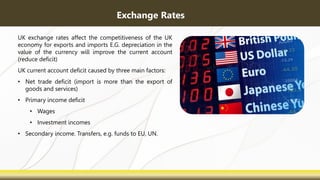The document provides an overview of UK financial markets and regulation. It discusses the UK government's role in fiscal and monetary policy to manage the economy. It also covers topics like the money supply, interest rates, inflation, and the Bank of England's tools to implement monetary policy including quantitative easing and open market operations. International financial regulatory bodies and markets in other countries like the US, Europe, China and Hong Kong are also summarized.


































































